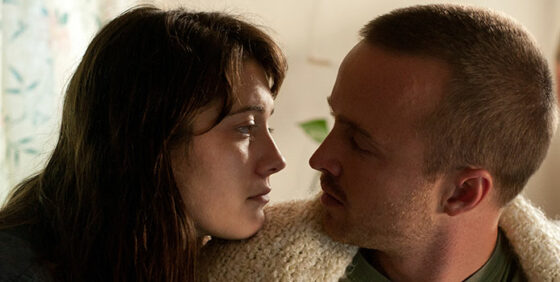TIFF Day 3: Far from Afghanistan | Anna Karenina | Argo | Blancanieves | Clip | Hyde Park on Hudson | Juvenile Offender | The Land of Hope | Lunarcy! | Out in the Dark | Smashed
The Discomforts of Home: Far from Afghanistan (John Gianvito, Travis Wilkerson, Jon Jost, Minda Martin, Soon-Mi Yoo, USA)—Wavelengths
By Aaron Cutler and Mariana Shellard
When Chris Marker gathered his Nouvelle Vague and Left Bank colleagues to make the omnibus film Loin du Viêtnam in 1967, nearly half a million American troops were stationed in Vietnam and, as the film’s opening stated, more than 200 million bombs had been dropped on the country, already more than were dropped on Germany during the Second World War. The film mixed personal reflections with debate over the perpetuation of the colonial system. A massive protest responds to Vice-President Humphrey’s visit to Paris; an American parade surges forth in support of the war with marchers crying, “Better dead than Red!”; in a bombed-out North Vietnamese village, a pair of actors pantomime for a crowd, the actress playing Lyndon Johnson weeping over a lost F4H plane and then both performers singing the refrain, “If you have any wisdom go back home.” “Are you going?” asks a Black Power leader in Central Park, and the multiracial crowd roars, “Hell, no!”
When American filmmaker, programmer and teacher John Gianvito resolved to make a multivocal feature modelled after Loin du Viêtnam last year, the war in Afghanistan was approaching its tenth anniversary, surpassing Vietnam as the longest overseas conflict in American history. The Taliban had been deposed and replaced with a brutal, corrupt but pro-US government, Osama bin Laden had been killed, and President Obama had sent a reinforcement of 30,000 troops to quell insurgency and maintain order in the country, with an announced withdrawal date of 2014. Military spending on Afghanistan was also more than twice what it had been at the start of the war, and civilian casualties had risen for the fifth straight year, according to a United Nations report. And yet the war still seemed to be invisible to most Americans. Gianvito contacted several directors based in the States as well as members of Afghan Voices, an Afghanistan-based organization teaching documentary filmmaking to young people, to create and combine short works focusing on different aspects of the war. Far from Afghanistan counterpoints vignettes from the American homefront with Afghan Voices’ interviews with Afghan civilians in the streets, hospitals, and their homes and offices. Where Loin du Viêtnam was a series of manifestos intended to place an array of perspectives on the war in dialogue with each other, Far from Afghanistan exposes a prevailing sense of individual alienation and helplessness in the face of a seemingly interminable war.
CINEMA SCOPE: What inspired you to make Far from Afghanistan?
JOHN GIANVITO: A desire to bridge the distance. I had read this Pew Research Report study that I cite in one of the texts onscreen that at the end of 2010 only four percent of all U.S. media made any kind of mention of the war, and eventually at the end of 2011 it was down to two percent. And yet statistically these were the deadliest years in the decade of fighting, and so at its most exacerbated moment, we were paying the least heed to it. I felt and still feel that unless you have a personal connection to it, you can go weeks or months with almost no cognizance that we’re involved in a major war. And though I don’t have children, I had this image one day of a child saying to me, “So Dad, you consider yourself a political filmmaker. What did you do during the longest overseas war in U.S. history?” That thought, combined with the awareness that in October 2011 it was going to mark a decade of involvement, made me feel I didn’t want that somber anniversary going by without doing something.
Gianvito’s opening segment “My Heart Swims in Blood” contrasts scenes of American daily life with voiceovers reporting Afghan casualties and facts about the war. People pass time in a shopping mall, and an amusement park, a train station, a video-game convention; meanwhile, offscreen voices report Afghan civilian casualties. Americans dance and drink in a discotheque while a news report informs us that on October 28, 2001, a US bomb flattened a flimsy mud-brick house in Kabul, blowing apart seven children as they ate breakfast with their father; the blast also shattered a neighbour’s house, killing another two children.
The scenes of leisure alternate with an old man lying alone in a house in the woods, trying to sleep. American lives and Afghan deaths are distant and disconnected from each other. But average Americans, however distant from it, are impacted by the war due to the resources of which it robs them. Afghan speakers intercalate stories of civilian casualties with a lone American female voice giving statistics; the Department of Defense’s 2011 budget was $719 billion, we hear, more than thrice as much as what the UN estimates could solve world hunger. “Why do they hate us?” a voice asks. In close-up, an owl moves its head in pursuit of something we cannot see.
SCOPE: What is your relationship to the war in Afghanistan?
JON JOST: I spent over two years in prison, from 1965 to 1967, for refusing to serve in the military. I regard the US government as a criminal/amoral/immoral organization that largely works at the behest of corporate powers and their profit-making/imperial interests. The Iraq War and the Afghan War were intended, however much those goals have backfired, to be resource grabs, cloaked by the argument that we were fighting al-Qaeda (which we more or less invented to fight the USSR’s occupation of Afghanistan in the 1980s). In the fashion of our latter-day overseers, they were deliberately done in a highly “privatized” manner: no draft, no taxes raised, massive expenditures to the military-industrial complex, and all cheered on by the corporately owned and controlled mass media. The present economic decline, the fracturing of the sense of the commonwealth, the disintegration of our public union have all been exacerbated and even accelerated as a result. Unlike most wars, which tend to unify the public, the utterly fraudulent and deceitfully orchestrated Afghanistan and Iraq wars have done the opposite, and amplified the already existent distrust of government.
Jon Jost’s “Empire’s Cross” unfolds wordlessly at first, with the familiar image of a plane crashing into a tower. As the images repeat, they force the viewer to see September 11th as a spectacle as well as a tragedy. Most who saw the attacks watched them on television, where they unfolded with the hyper-reality of a blockbuster Hollywood production. The government took the opportunity soon afterwards to tell its citizens how to react, invoking the necessity of war. A Time Magazine poll taken less than two weeks after September 11th showed a majority of Americans desiring to go to war, though most of them were unsure with whom. The film shows the ensuing war unfolding the same way as did that initiating tragedy had: on television, from a mediated distance.
Repeated, pixillated images of bombings fade into clear views of ancient stone warriors. The soundtrack shifts from a cacophony of intercom communications and snatches of Dwight D. Eisenhower’s warnings about the military-industrial complex to the sound of running horses, as the warriors fade in and out of view. “We pay for a single fighter with a half million bushels of wheat. We pay for a single destroyer with new homes that could have housed more than 8,000 people,” declares text from Eisenhower’s speech. Empires rise and fall by wasting resources; Eisenhower’s words help account for imperial decay.
SCOPE: There’s a big difference between Loin du Viêtnam and Far from Afghanistan, which is that in the first film you feel the war on the skin. Far from Afghanistan has a more phantasmagoric spirit. It’s almost like the war is being hidden from the public.
SOON-MI YOO: I agree with you. An interesting thing is that the Korean War was like that. There were no television cameras that would bring the war “home” to American viewers, unlike Vietnam. Several millions died, mostly Koreans, but I think it is considered “forgotten” partly because of this lack of exposure, immediacy. It is also because the war never ended. It was the first war the US didn’t “win.” The Vietnam War was different. Even though it was another war in a faraway place people didn’t care about, people didn’t have much choice but to confront its ugly reality. We’ve all seen the images. It was also a different time politically. With the war in Afghanistan, although we can now see what is happening in real time technologically, it is once again so hidden and far away—because of the current state of politics, and because of public indifference, really, a sort of fatigue with what is going on in the world. People don’t know and also don’t pay attention. I see this especially in America. When you’re in the centre, you don’t gain much perspective, because a perspective only comes when you have some distance from it. I think a lot of Americans are very self-centred—not necessarily because they want to be, but by default.
Soon-Mi Yoo’s “Afghanistan: The Next Generation” juxtaposes scenes of Afghans from American propaganda made during the Soviet invasion of Afghanistan with scenes of contemporary Afghan life. The laudatory Western testimonials to the bravery of the Soviet-era mujaheddin ironically remind the viewer of the US government’s contributions in cash, arms and education to the regime that it would unseat little over a decade later—though without finding a corresponding way to dislodge the ideology of holy war that the Taliban had instilled. An Afghan youth in the archive footage says, “If this older generation is gone from this world, jihad must not stop.”
We also see scenes from Afghan Voices of modern-day children, including a young girl named Fatima (previously introduced in an interstitial segment) who is studying to be a doctor. The segment implies an ambiguous fate for Afghanistan’s next generation. The juxtaposition of the past and the present makes us wonder in what direction it will go, as well as whether the American occupation of Afghanistan will end in the manner as did the Soviet.
SCOPE: What responsibility do Americans hold for the war?
MINDA MARTIN: As someone closely related to people involved (I have family who have served and are still serving) and as a concerned citizen, I think war should be at the forefront of our minds, as though we are living inside it. It’s too easy for us to slip into apathy, because we are so far away from it. American civilians are as responsible for Afghan deaths as soldiers are. Soldiers are doing a job that we ask them to do. They are part of the structure. Why aren’t we asking the President more questions about his role? Why are we standing by as lawmakers continue to make choices paying for this war and various bases around the world while they make drastic cuts to education, research, infrastructure, and other vital social services that protect and empower all Americans?
The Gulf War was the American public’s introduction to long-distance warfare, where remote-operated bombs and missiles met their faceless targets on a computer screen with the bloodless satisfaction of a video game. Minda Martin’s “The Long Distance Operator,” Far from Afghanistan’s sole fictional narrative, shows two soldiers directing a bomber plane over Afghanistan from a control base in the States. That night, one of them (played by John Armenta) talks to Afghanistan-deployed fellow soldiers on Skype who tell him that the bombs have been hitting civilians, and that witnessing the devastation they cause has led them to understand, and even sympathize with, the formation of resistance movements. The homefront soldier tries to explain that it’s not his fault, and that he can only rely on the information he’s given.
The segment expresses a hierarchical system of neglect, in which deployed soldiers suffer from the consequences of bombings, while the pilot lives with his conscience in isolation as he receives commands from invisible superiors. Its actors are real-life Afghanistan and Iraq veterans, and its real-life combat footage came from WikiLeaks. The segment is inspired by Ethan McCord, a soldier who testified about seeing Iraqi civilians killed in an aerial strike, and dedicated to PFC Bradley Manning, a soldier currently imprisoned for releasing confidential war footage through WikiLeaks. It bridges fiction and documentary, mirroring the way in which the war has become, for many people, an unclear mixture of the two.
SCOPE: In your segment you show interviews with two women, the wife of one American soldier who committed suicide and the mother of another. How did you find them?
TRAVIS WILKERSON: Through my political work with the ANSWER coalition, I’d become close friends with Mike Prysner, a super-radical Iraq War veteran who’d co-founded the most militant wing of the anti-war vets, called March Forward! They were taking a trip up to Ft. Lewis in Washington to help organize a speak-out at a vet’s coffee shop just off-base against the epidemic of soldier suicides. Just before, in June 2011, there had been the most active-duty suicides in the history of the military. [July 2012’s total surpassed it.] The two women both participated in that speak-out. No one, and I mean no one, was listening to them. They told us over and over again how isolated and ignored they felt. Women’s voices are always treated as secondary in war, if not ignored altogether.
Partway through the trip I was detained, illegally, by a huge group of armed MPs near the gate of the base. I was filming yellow ribbons tied along the bridge leading to the gate. Within my first three shots, they had already detained me. They questioned me for a while, insisted I delete the photos, and then finally released me. Before I’d walked 100 yards they detained me again, and we went through it all one more time. They cared a lot more about the possibility of bad publicity than they did about whether soldiers under their command were killing themselves in record numbers.
Travis Wilkerson’s closing segment “Fragments of Dissolution,” filmed in high-contrast black and white, listens to the stories of four American women: two relatives of soldiers who have committed suicide, and two relatives of victims of fires caused by illegal electricity hook-ups. Staff Sergeant Derrick Kirkland’s wife was pregnant when he enlisted; he had previously been working as a line cook at a Steak ’n Shake in Indianapolis. The Army promised his family a better future, but depression overtook him after his first deployment in Iraq. He tried repeatedly to kill himself during his second deployment: first in Iraq, then in Germany, then at the military base in Ft. Lewis, Washington, where he was medically classified as a low-to-moderate risk, and where he finally succeeded. His mother was told by another soldier that a superior officer in Ft. Lewis called him a liar and a coward. “And this is a leader?” she asks onscreen. “That’s where it starts—if it’s coming from the top, it trickles on down.”
American wars have always been fought by the country’s poorest, and now that there is no legal draft, a poverty draft has taken its place. But soldiers and their families are just some poor Americans, as the percentage of the population living in poverty has reached a 50-year high. Detroit resident Sylvia Young, whose voice we hear over images of poor urban houses, grass, and children’s toys, lost three of her seven children in a winter 2010 fire, after which the state tried and failed to prosecute her and claim custody of the other four kids. The fire broke out because her lights and gas had been cut off by a representative of the corporation Detroit Edison (DTE), and she had had to make an illegal hook-up to keep her children warm. As with the war, the American government and large corporations profit together at the poor’s expense. Impoverished Americans continue to give their incomes to taxes without either the growth or the relief their wealthy counterparts receive. They do not just fight wars, but also maintain them.
The poverty decried in Far from Afghanistan likely is not shared with most of its prospective audience, and while the information it conveys is hardly new, this is not the film’s purpose. The greater impoverishment Far from Afghanistan discusses is maintained and even strengthened by each person’s implicit consent to the system responsible for it, and the film’s different segments and forms of representation can help raise an awareness of that consent.
The film ends in Afghanistan, with a protest rally against the American occupation. The protest leader states that Afghans’ social, economic and individual rights have been taken away. Then a quick succession of images show urban traffic, street markets, young Afghan men being trained for military duty, and schoolchildren passing by and staring into the camera. In Loin du Viêtnam, Chris Marker’s voiceover described the inevitable result when one group fights for profit against another group fighting for survival. While watching these last scenes of Far from Afghanistan, one can imagine hearing his still-relevant words:
The choice of the wealthy society is simple: it should implement the physical destruction of all that resists it, a task that goes beyond the risks and its means of destruction, or transform itself entirely. This might be too much to ask from a society at the height of its power. If its members reject this choice, they should sacrifice their illusions of tranquility, accept the war of the poor against the rich as inevitable. And lose it.
Anna Karenina (Joe Wright, UK)—Special Presentation
By Kiva Reardon
Having wreaked enough carnage on Brit-lit both canonical (Pride and Prejudice) and contemporary (Atonement)—with a brief and bizarre sideline into high-kicking action-sci-fi with Hanna—Joe Wright now turns his sights on the Russian canon, warping Leo Tolstoy’s Anna Karenina into an experiment in directorial self-indulgence. Not much can be said for what Wright brings to the Tolstoy text, for it seems his project is to make the film about the process of adaptation itself, with theatrical tricks ad infinitum. Much of the action plays out in a threadbare theatre, the settings elaborately flipped on screen as we move from scene to scene. For the first twenty minutes of the two-hour plus film, this feat is technically impressive, but it quickly wears thin; what’s more, Wright’s commitment to this stagy aesthetic ultimately proves flimsy, as the theatre soon opens up to the Russian countryside and the film becomes a basic period piece, complete with Keira Knightley’s dramatically lit cheekbones. Had Wright worked through (and within) the very apparatus of adaptation which he continually draws attention to, Anna Karenina may have proven to be if not a successful narrative film, at least a distinctively ambitious one. As it stands, the gesture merely reeks of having it both ways: shabby and chic, removed and intimate, filmic and theatrical. And the point seems only to be to prove that he can.
Argo (Ben Affleck, USA)—Gala Presentation
By Jay Kuehner
“Argo Fuck yourself” chides a cynical Hollywood producer (Alan Arkin) faced with handling the preposterous script optioned by undercover federal agent Tony Mendez (Affleck), who is contriving to extricate American diplomats trapped inside Iran during the hostage crisis by disguising them as a Canadian film crew. Based on real incidents declassified by the US government in 1997, the case is stranger than fiction and absurd enough for, who else, Hollywood. It would be opportunistic to call this a politically timely film, given the state of US/Iranian relations, except Affleck has succeeded in a deception all his own by turning history into pure entertainment (ultimately tragic, this farce).
Diversion alone does not seem to be the problem in either case; where Mendez and company feigned a ridiculous rescue operation premised on a science-fiction fantasy in the Middle Eastern desert, Affleck hides an ultimately sentimental and patriotic drama inside a political thriller. Cueing to the period’s own cinematic Zeitgeist, Argo is convincing in its verisimilitude, harkening back to a harder-boiled late ’70s aesthetic. But Affleck betrays his directorial skill, and confidently clever performance, by treading earnestly on some rather incredulous narrative terrain. Taking liberties is what US diplomacy and Hollywood have in common, and Argo conflates them with a typical sense of bravado. Regrettably, my perception of the Iranian conflict is left unchanged since my earliest childhood memory of an international political phenomenon, beamed from a television, of which I knew little more than Ted Koppel’s coiffed mane, the Ayatollah’s epic beard, Jimmy Carter’s southern drawl, and yellow ribbons tied to schoolyard fences. Looking forward to a Makhmalbaf version.
Blancanieves (Pablo Berger, Spain/France)—Discovery
By Gonzalo de Pedro Amatria
It’s hard to explain such an specific word as españolada, but it’s important to understand what Pablo Berger is doing with his cinephilic homage Blancanieves (Snow White). (It comes nine years after his first film, Torremolinos 73, which was a personal homage to home-made porn movies). Españolada is the word used to talk about a certain way of representing Spanish culture, as if it was only a country inhabited by toreros, gypsies, and flamenco singers and dancers. This romantic idea of Spain was started in France in the 14th century and still persists today: Spainish tourist agencies still partake of españoladas all the time. Berger´s film take the españolada and re-reads it in a very ironic way, as what it is in reality: a cultural invention, a folklorical business— the society of the spectacle. Berger takes the Snow White tale and rewrites it, mixing low culture with visual references out of high culture (of cinema, specifically). There are references to Jean Vigo, Abel Gance, and Carl Theodor Dreyer among others, but the film is not just a postmodern compendium of quotes: it’s a search into the past to find the forces that led to the cinema of the present. Minus the political overtones of another great homage to old cinema— Miguel Gomes’ Tabu—Berger´s film is more a tale about envy, love and death, mixing comedy with a great sense of visual spectacle, than it is a reflection about history and cinema.
Clip (Maja Miloš, Serbia)—Discovery
By Michael Sicinski
This film is just gross. Clip is one of those “shocking” works of tittle-tattle artsploitation that seems to imply by its very existence that staging irresponsible teen behaviour for the camera is the same as critiquing it. What’s more, Clip and its first-time director also clearly fancy themselves sufficiently hip and edgy (they are down with the(se) kids, got it?) that anyone lodging an objection—Was this blowjob necessary? What do we gain by watching three thugs beat down some guy, then get blowjobs?—is just a prude. Miloš is ostensibly providing a portrait of young Jasna (Isidora Simijonovic), a surly teen who likes to dress like a slut and video herself acting like a porn star with her mobile phone, sometimes solo, sometimes with her slutty friends. She eventually gives herself over to Djordje (Vukasin Jasnic), a sub-verbal chav who, as the book says, is just not that into Jasna. But she remedies this with more blowjobs, giving up the anal, and eventually wearing a leash and barking like a dog. Clip doesn’t end so much as it sputters out like a keg at 4 a.m., and while Miloš may think she’s providing psychological and sociological context in between the coke-snorting and puke, her attempts are laughable. (Jasna’s family life is, you know, hard. And cellphones make everything so, like, hyperreal, man!) At one point, a propos of nothing, a mate of Djordje’s yells out, “Bosnia is Serbia!” which leaves us with the saddest question of all: Is Jasna, the coked-out, sexually degraded party doll, supposed to be some allegorical figure? Has Serbia finally produced a bigger whore than Emir Kusturica?
Hyde Park on Hudson (Roger Michell, UK)—Gala Presentation
By John Semley
The closing title cards of Roger Michell’s uniquely awful Hyde Park on Hudson makes a point to remind you that by 1942, American and British troops were fighting “shoulder to shoulder”—the suggestion being that America’s declaration of war was an eventuality stemming from a series of cordial meetings between Franklin D. Roosevelt (Bill Murray) and King George VI (Samuel West) held at the US president’s sprawling country estate in Hyde Park, NY. Forget the attack on Pearl Harbor: Hyde Park on Hudson implies that America’s entry into the Second World War was just FDR making good on an implicit gentleman’s agreement, a response to the time when King George humbled himself before America by biting into a hot dog, a day that will live in infamy.
So Hyde Park on Hudson is not, in any meaningful sense, a historical drama. Rather, it’s a moronically schmaltzy weepie that uses the diaries of Roosevelt’s fifth (or sixth) cousin and lover, Margaret “Daisy” Suckley (Laura Linney), as an entry point into the 1939 meeting between England and America. Daisy’s the fly-on-the-wall, but the bulk of the film’s talky action (a fancy dinner, a closed-door cocktail tête-à-tête between King George and FDR) shuts her out entirely, leaving not so much as a keyhole to peep through. Linney’s flat, vacuous Daisy offers nothing but a lurid way into this lost weekend; Michell barely attempts to dramatically invest in Daisy and her distant cousin’s sexual liaisons (she was apparently one of a harem of mini-concubines that the former president kept scattered throughout cabins in the hills around Poughkeepsie). Her revelation that her secret lover is pursuing more than an extramarital affair is sunk by cliché horror tropes, as she flees the president’s aides hightailing it through the forest. The voiceover seems like the stuff of escapist historical erotica, if such a genre even exists. (If not, we have Hyde Park to thank for stumbling over its invention.)
Following from the competently prestigious The King’s Speech (2010), Michell and writer Richard Nelson seem to be indulging the filmgoing public’s manufactured interest in watching actors dress up as the more opaque political figures of the last century. While Olivia Williams is briefly memorable as a stern, disinterested Eleanor Roosevelt, Murray’s FDR amounts to broad caricature. He’s a talented actor, no doubt, but he realizes the former president as nothing more than a bundle of coy affectations: fumbling with a cocktail shaker in a tuxedo, leering over his stamp collection in the dark, cracking wry, and chomping on his cigarette holder. The royals offer similarly waxy performances, though it’s nice to see an actor even paler and more potato-faced than Colin Firth taking a turn as King George. Like the film, the performances are entirely inert: designed with the assumption that they’ll be admired without having to actually do anything. Absurdly, the only thing approaching a narrative arc in this film involves George and Queen Elizabeth’s (Olivia Colman) hesitance about eating frankfurters at a picnic, fussing through the night about what it represents. It’s another attempt to humanize the poor, misunderstood royals that evolves into incidental lampoonery as it becomes apparent that Michell is entirely serious about this hot-dog business. It’s tempting to say that Hyde Park is itself fit for the sausage grinder. But who would want to waste a perfectly good intestinal casing?
Juvenile Offender (Kang Yi-kwan, South Korea)—Contemporary World Cinema
By Richard Porton
The TIFF blurb for Korean director Kang Yi-kwan’s Juvenile Offender, which compares it to classics such as Rebel Without a Cause, Les quatre cent coups, and L’enfance nue, does something of an inadvertent disservice to Kang’s admirable film. The appeal of this refreshing twist on the teen angst movie is generated more from its nuanced portrait of an anti-heroic protagonist than any aspirations to speak for a disenchanted generation or disseminate insurrectionary bromides. Ji-gu (Seo Young-ju), the eponymous “offender” —or, to employ outdated lingo, “juvenile delinquent”—is actually a screw-up without a cause. At the film’s outset, the orphaned 16-year-old, on probation from a detention centre, attempts to deal with his ailing grandfather’s diabetes and the pangs of first love as he confides with his girlfriend. Before long, Ji-gu’s poor choice of friends winds him up sentenced to another term in “juvie”; the poor kid even proves ineffectual as a petty thief.
When Ji-gu’s mother , a woman who alternates between bouts of nervous giggling and protracted temper tantrums, turns up unexpectedly to release her son from detention, Kang’s movie is transformed into a complex pas de deux where the audience is encouraged to empathize with this pathetic duo without excusing their flaws. The strength of Juvenile Offender lies in its refusal to depict its protagonists as either victims or culprits. To a certain extent, it’s clear to a Western audience that Ji-gu is spurned by a society where academic and social failure is considered a disgrace. Nevertheless, he and his equally hapless mother are never condescended to as objects of pity; they are given autonomy as characters and allowed to sabotage their own lives. Juvenile Offender’s restrained naturalism is the perfect antidote to the moralizing that is often an integral component of the “social problem film.”
The Land of Hope (Sono Sion, Japan)—Contemporary World Cinema
By Michael Sicinski
Ever since 2008’s magnum opus Love Exposure, there have been two aesthetic tendencies battling for dominance inside Sono Sion’s cinema, if not his skull. There’s an “Asian Extreme”/midnight moviemaker side to Sono leftover from his earlier, underwhelming genre efforts. (Anyone ready to go to bat for Exte: Hair Extensions? No?) Fundamentally misdirecting some of the anarchic energy from his Super-8 efforts, this schlockmeister badassery has continued to yield dreck like the recent Cold Fish (“Hey, nebbish! Rape your wife until you’re a man!”) and the tedious, sub-Lynchian Guilty of Romance. At the same time, there’s the careful, meticulous director of uncertain moods and human lives in transition. This was frequently visible through the bloodstains in Noriko’s Dinner Table, and the recent Himizu demonstrated that this subtle, probing Sono might well be winning out.
Great news: The Land of Hope is easily Sono’s best film since Love Exposure, and bests that achievement in a number of key respects. As with fellow “Japanese outlaw” Miike Takash, Sono will undoubtedly experience some blowback for this one, since it is his most outwardly tasteful and professional effort to date. But as it happens, “blowback” is just what The Land of Hope is about—specifically the aftermath of a nuclear disaster following a catastrophic earthquake. (Sono filmed in the environs of the now empty Fukushima area, and the Fukushima quake and radiation crisis is referenced in The Land of Hope, but the film depicts a later, fictional emergency in Nagashima.) Although Sono’s scope is wide, most of the activity centres around the Ono family, in particular the dairy-farmer patriarch (Isao Natsuyagi) who cannot evacuate for fear of traumatizing his wife (Naoko Otani), who suffers from Alzheimer’s and comforts herself by working in her garden.
Although The Land of Hope adopts a steady pace and displays a sturdy, surefooted sense of spatial construction (courtesy of novice DP Shigenori Miki), Sono isn’t exactly playing it straight. Yes, the film opens with a classic low-angle Ozu mealtime scene, but the son, Yoichi (Jun Murikami), is notably late, darting into the sequence just in the nick of time. This could be an oblique comment by Sono on his own relationship to his forebears: the Japanese modernism of the first half of the 20th century, its formal exactitude connected to a commitment to social decorum, no longer holds. As Ono-san rails against the lying authorities, those same authorities show up, “handling” the radiation problem with a solution straight out of Imamura. By the film’s conclusion, Sono offers sociopolitical marginalization and emotional compromises befitting Douglas Sirk. Check the Geiger counter: something’s in the air, all right.
Lunarcy! (Simon Ennis, Canada)—TIFF Docs
By Adam Nayman
Lunarcy! earns its exclamation point: Simon Ennis’ documentary about moon maniacs is fast-paced and high-spirited in the best tradition of Ron Mann (whose name is on the credits as an executive producer), but it’s not an in-house Xerox. If Mann’s great talent is for fast, cheap and semi-out-of-control tours of various eccentric subcultures, Ennis is more interested in holding up and trying to understand what makes individual misfits tick. That was the raison d’être of his underrated comedy You Might as Well Live! (2009), which managed the tricky feat of being caustic and sweet (and maybe a little bit sentimental, if such a thing is possible in a movie with Stephen McHattie in full John Wayne Gacy drag). Lunarcy! has its own wobbly hero in Christopher Carson, a bespectacled young man who looks like an artist’s conception of a nerd and who believes it is his destiny to relocate to the Moon, a journey enacted in a series of small steps en route to a giant leap (of faith).
The obvious talking point for a movie like this is whether it “condescends” to its subject, but that’s not really relevant here: Carson pretty much knows how he comes off to other people, and speaks with enthusiasm and pride about his aspirations. If he emerges as the most attractive figure in a movie that orbits its share of heroes (authentic astronauts) and hucksters (Denis Hope, who has been selling plots of lunar land since the 1980s), it’s because Ennis lets us see his ultimate goal as something relatable (who doesn’t dream of escape?) rather than ridiculous. Or maybe he refreshingly chooses not to differentiate between those two polarities, an act of artistic solidarity that pays off in an ending that permits more wish-fulfillment than most non-fiction films would dare—and accordingly generates more feeling than most of those movies could muster.
Out in the Dark (Michael Mayer, Israel/USA)—Discovery
By Adam Cook
Out in the Dark belongs in that dishearteneningly broad category of films with worthy subjects and unworthy filmmaking. Israeli director Michael Mayer contrives a star-crossed gay love story between a Palestinian grad student, Nimr, and an Israeli lawyer, Roy, who try to maintain a relationship in spite of the looming threat of Nimr’s conservative family (who are unaware of his sexual orientation) and the obvious obstacles posed by the regional conflict. To make matters worse, Nimr’s brother is involved in violent actions that could (and will) compromise his sibling’s happiness.
Worse than the contrived narrative and the exploitation of a serious political backdrop is the rack-focus-happy DSLR filmmaking, a trend that has well outworn its welcome, and a bargain-bin sensuality that feels too soap-operatic to justify the film as the romantic drama it wishes to be. I gave up counting the close-ups, and let’s not even delve into the perpetual guitar swells on the soundtrack. Out in the Dark comes off as cheesy and shallow, and does more harm than good in taking on a conflict which has produced enough genuinely tragic stories which scarcely require music cues and film-school technique to solicit our empathy.
Smashed (James Ponsoldt, USA)—Contemporary World Cinema
By José Teodoro
Mary Elizabeth Winstead is so adorable that it isn’t difficult to imagine having fun with her while doing virtually nothing. Which is a good thing, since her best moments in Smashed find her doing little more than riding a bike while smashed, teaching grade one while smashed, trying to have incredibly bad bouncy sex while smashed, nattering nervously to a homeless man while smashed, or peeing on a grimy convenience store floor while smashed. Of course, these are all more or less calculatedly outrageous things that Winstead does before catching a mortifying glimpse of rock bottom, accepting an invitation to her first Alcoholics Anonymous meeting and setting out on her arduous 12-step journey toward sobriety. Kudos to director and co-scenarist Jeremy Ponsoldt for chronicling this journey with truly impressive economy; little time is wasted on exposition or on establishing his heroine’s hidden strengths, weak points and roadblocks. But this same economy also lays bare the film’s rather slavish fidelity to the well-worn mechanics of the recovery narrative; the inevitable chain of small betrayals and humiliations quickly start to feel rote. Scenes of confrontation between Winstead and her employer (Megan Mullally) and Winstead and her husband (Aaron Paul) are especially forced. The film’s only significant twist on the familiar trajectory concerns the difficulty of getting sober when the love of your life wants to keep the party going. But the closing scenes of Smashed backpedal on the brutal fact that some people can drink and some people can’t, and when you put those people together, longevity is virtually impossible.
cscope2












